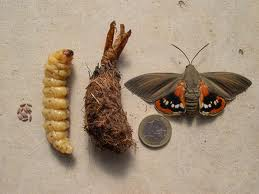This pest native to South America, Uruguay, Paraguay, central Argentina has been accidentally introduced to Europe in the 90’s. It can be found in Spain, Italie. In France all the departments of PACA (Provence Alpes Côte d’Azur and Languedoc Roussillon are affected; now it is spreading to South West of France.
The scientific name for this moth is Paysandisia archon it belongs to the family Castniidae (Lepidoptera), most members of which live in South America where it is not consider as a pest.
The adult is a beautiful moth, with a large wingspan of 9–11 cm. The fore-wings are olive brown-colored and the hind-wings are brightly colored with red, black and white The antennae are clubbed. Females are a little larger than the male. The eggs are laid separately; they are oblong (5 mm long), cream-colored and with longitudinal ribs. Just after hatching, the larva is pink-colored and less than 1 cm long, but turns white as it grows. It reaches 6–7 cm at the end of its development, looking a bit like a grub.
The observations suggest that the moth has a long cycle of development. The adults are observed from June to September. They are active during the day. All stages of development, from egg to chrysalis have been recorded at the same time, in July. The egg is laid at the basis of the leaf on the stem or in the terminal bud. The larva bores a gallery through the stem or through the young leaves causing characteristic damage. When several larvae bore simultaneously in the stem, the palm becomes weak and can even die. Except for the period when the adults are flying, it is difficult to detect the presence of the pest; at the larval stage the only sign may be the presence of plugs of debris, like sawdust, visible at the outermost extremity of the gallery. The larva turns into a chrysalis, protected by a cocoon made with palm fibers inside the gallery. At the very end of its development, the chrysalis frees itself from the cocoon at the outermost extremity of the gallery, and a new adult moth is born after tearing this envelope. The remains of the chrysalis are often attached to the exit hole of the gallery for a while.
Damage
The damage is observed at different levels of the tree: leaves, rachis and top of the stem. Once hatched, the larva bores towards the heart of the palm and if several larvae are present on the same tree, this can lead to the death of the palm. Big palms can survive if they are not too severely attacked, but small ones or plants in the nursery or in containers are very exposed to attack.
How to treat it
If the trees are too far gone they have to be destroy them by burning.
You can put a special kind of glue on your trees as a preventative measure (it kills the larvae).
Also there are natural predators, such as the nematode worm.
Bibliographie :




No comments:
Post a Comment